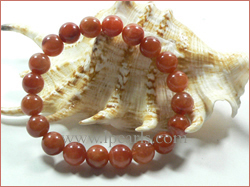
The bead core goes into the mollusk and nacre is formed around the core. The core determines the overall shape of the pearl. How long the oyster is allowed to let the pearl grow determines the thickness of the nacre. Thicker nacre is better. Best of all is thick nacre and a smooth, almost blemish free surface. Pearls grown inside the mussel or oyster do have a gritty feel to the tooth.
Fake pearls are made by coating a core of some sort (mother-of-pearl, plastic, etc.) with a plastic, a kind of paint containing ground fish scales or other stuff that look pearly to the eye. Generally, the fakes do not have a gritty feel to the tooth. Most may be identified with a little practice and a 10x jewelers loupe or microscope. The way to do it is to compare real pearls with some known fakes. The fakes almost always show a grittier look to the surface and not the more smoothly formed natural nacre.
The look is grittier but the feel to a tooth is smoother. After some practice comparisons, most fakes are fairly easily identified. Still, some are hard to detect without very thorough testing sometimes using solvents and acids which attack the real pearl nacre but not the plastic fakes and visa versa.
Other than that, a look at the drilled holes in the beads will help. Since the pearl is formed naturally without a hole, the hole must be drilled. The surface of the pearl at the drill hole will not 'sink in' or 'rise up' as is seen in many fakes that are formed and coated with the holes already made to the core. In the real pearl, the nacre will be smooth with the drill hole and might even be chipped a bit. Some folks recommend having a dentist do an x-ray to see what is inside.
Still, unless a person is very, very familiar with reading the images the results are very iffy. A core will look like a core whether in a fake or a cultured pearl. A core will not be present to any large extent in a pearl formed freely in the ocean but those pearls just are not around or to be had except in very small sizes.
Using a good loupe (hand held magnifier) of 10 power is likely the best home test. Of course, try the teeth first! Then look at the drill holes and the surface compared to a good cultured pearl. There is not a one-in-all test I can recommend. Some of this will simply require some 'pearls' of real and fakes for comparison. When you look through a 10x maginfier at the surface of most fakes, the surface might look gritty, uneven, "orange peel" as in paints or even flaked off in small places.
On some day, one of my friends carry a wide selection of pearl jewelry, from pearl beads, cultured pearl strands, freshwater pearl neckalce, pearl bracelet, wholesale pearl ring, freshwater pearl earrings, other shaped pearls and cultured pearl pendant, freshwater pearl earrings to cheap sterling silver jewelry and full sets of pearl jewelry, expertly hand-crafted using only the fines pearls by pearl wholesale store to me. I am a jewelry lover, in my spara time I often find some single pearl necklace on the market and internet, especially on the internet, a various world, in there you can find whatever you want and find your interest on there..
Orignal From: The bead core goes into
没有评论:
发表评论